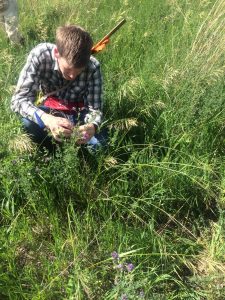In 2009 and 2010, porcupine grass (Hesperostipa spartea, a.k.a. “stipa”) was planted in experimental plot 1. In total, 4417 seeds were planted, 1 m apart, 10 cm north of Echinacea plants. Between 2010 and 2013, each position was checked, and the plant status recorded. Since 2014, we have only searched for flowering plants. This summer, 143 flowering stipa were found, with a median of 24 fruit per plant. We also checked for living plants in positions where stipa was observed in 2011 or 2014. In these additional 492 positions, 89 plants were found alive, with 19 of those plants flowering.
The following table shows how many plants have been found alive in each year.
| Year | Found | Flowering | Full Fruit |
| 2010* | 702 | ||
| 2011 | 483 | ||
| 2013 | 442 | 4 | |
| 2014** | 32 | 32 | 199 |
| 2015*** | 26 | 1 | 9 |
| 2016**** | 208 | 143 | 4391 |
(*) only one cohort (2009) included, (**) only searched for flowering plants, (***) only searched prior year’s flowering plants, (****) only searched flowering plants + subset of positions
Start year: 2009
Location: Experimental plot 1
Physical specimens: Fruits from 127 flowering plants, currently stored at the lab in Chicago. These may be used in a future study on traits of stipa‘s awns.
Data collected:
- Culm count and number of fruits recorded on visors (backed up to CGData)
- Fruit harvest information recorded on paper (stored at Hjelm house)
- Status of 2011 basal plants recorded on visors (backed up to as “2016stipaRecheck2011positions” in CGData)
Products:
- Josh Drizin’s MS thesis included a section on the hygroscopicity (reaction to humidity) of stipa awns. View his presentation or watch his short video.
- Joseph Campagna and Jamie Sauer (Lake Forest College) did a report on variation in stipa’s physical traits within and among families in 2009
You can find out more about stipa in the common garden and links to previous flog posts about this project on the background page for this experiment.


Leave a Reply